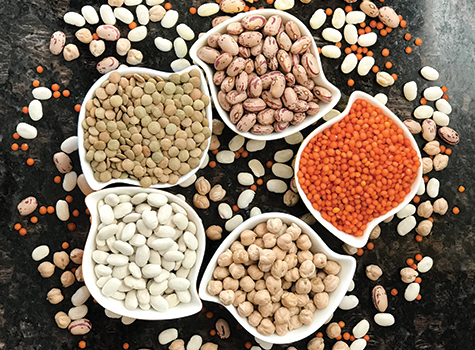By Parul Kharod

In the Southern part of the US, there is a popular saying, “Eat poor on New Year’s and eat fat the rest of the year.”
According to the Farmer’s Almanac, on January 1 millions will be serving up the traditional New Year’s menu of black-eyed peas and greens. It is believed eating these foods on New Year’s Day will bring good luck and prosperity for the remainder of the year.
Greens – (collards, mustard or turnip greens, cabbage, etc.) symbolize the green of “dollar bills,” and will ensure you have a financially prosperous New Year.
Black-eyed peas symbolize “coins,” and point to monetary gain.
In Italy, lentils are thought to bring prosperity for the year ahead when eaten on New Year’s Day.
But beans and greens don’t have to be eaten only on New Year’s Day! These foods have a lot of health benefits and should be consumed year-round on a regular basis.
Benefits of Beans (including all pulses)
Beans are highly nutritious and are an important source of fiber, amino acids, vitamins, minerals, and plant-based protein. Beans have important health benefits. They are rich in fiber, and keep you satisfied for longer than many other foods. Studies have found that eating a meal with beans and pulses made study participants feel fuller than a meal without beans. This can help with balancing blood sugars and hormones. Eating a high fiber diet that includes beans and pulses may help prevent chronic diseases such as diabetes, heart disease, cancer, and GI issues such as diverticulosis.
Beans are not only good for you, but also good for the planet. Beans foster sustainable agriculture and contribute to climate change mitigation and adaptation. Beans have a positive impact on the environment because they fix nitrogen in the soil, increasing soil fertility. Beans promote biodiversity. They also help increase organic matter and microbial biomass and activity (e.g., bacteria, fungi) in the soil. For this reason, they play a key role in crop rotation and the health of the planet.
Beans are economically accessible and contribute to food security at all levels. They are inexpensive to buy, have a long shelf-life and are stable during transportation. Beans are the cheapest form of quality protein and can help towards feeding more people.
Benefits of Leafy Greens
Dark green leafy vegetables are a rich source of many important nutrients.
All greens, including kale and spinach are rich in vitamins A, C, E and K. Bok choy and Mustard greens are also rich in many of the B-vitamins. They also contain high levels of fiber, iron, magnesium, potassium and calcium. The dark greens supply a significant amount of folate, a B vitamin that promotes heart health and helps prevent certain birth defects. Folate is also necessary for DNA duplication and repair which protects against the development of cancer. Several large studies have shown that high intakes of folate may lower the risk of colon polyps.
Dark green leafy vegetables have Vitamin K which can help with protecting bones from osteoporosis and helping to prevent against inflammatory diseases.
Green leafy vegetables may be one of the best cancer-preventing foods.
These vegetables contain a lot of antioxidants that protects the cells. Studies have shown that eating 2 to 3 servings of green leafy vegetables per week may lower the risk of stomach, breast, and skin cancer. These same antioxidants have also been proven to decrease the risk of heart disease.
Green leafy vegetables are high in fiber and very low in calories. This helps with achieving and maintaining a healthy body weight. Adding fiber rich greens also helps with balancing blood sugars and thus managing diabetes.
Beans and Greens Around the World
Beans and greens are eaten all around the world in different cuisines.
In India and Pakistan, spinach and mustard greens are cooked with chhole or chana daal. Spinach and mung daal or masoor dal is also a popular dish. These daals are also cooked with other leafy greens such as methi and gongura.
In Ethiopia, various greens are cooked with lentils or chickpeas.
In Italy, cannellini beans are cooked with milder greens such as escarole with lots of garlic! Another dish from the Southern Italian region of Apulia is bitter greens with dried fava beans.
Mexican cuisine also has black bean stews that are cooked with local varieties of leafy greens.
Mediterranean and Persian cuisines also have many variations of different greens cooked with a variety of beans.
Happy New Year!
Hope you start your new year by eating some beans and greens for good luck and continue to eat them through the year for good health.
———-
Parul Kharod, MS, RD, LDN is a registered dietitian and licensed nutritionist and works as a Clinical Dietitian with Outpatient Nutrition Services at WakeMed Hospital in Cary and Raleigh. She can be reached at parulkharod@gmail.com



